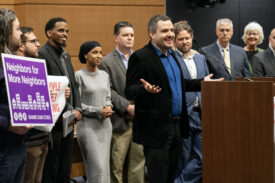The gist:
The trouble with the Northwest’s long-running debates over transportation is that the region has no method in place for prioritizing its spending on the basis of cost-effectiveness.
One promising approach is called least-cost planning, which is based on common sense. It involves cataloging and pricing each option (including long-term, social, and environmental costs), publicizing the results, and buying the best options first.
The details:
Least-cost planning was first designed by Northwesterners more than 30 years ago for a similar set of dilemmas in the electric power sector. In the mid-1970s, a talented local economist and computer modeler named Don Shakow showed the Seattle City Council how, by investing in energy conservation, the city could foreswear nuclear power.
Shakow’s innovation was to apply common sense rigorously. He catalogued scores of ways to supply or conserve, priced each option (including long-term, social, and environmental costs), and then–once the council had debated the options –assembled the most advantageous set of investments.
Based on this approach, the region stopped building large power plants and invested in conservation, which saved billions of dollars for ratepayers, and cut annual electric growth substantially.
In the 1990s, the Northwest’s transportation sector was in a similar situation: a mass of growth and congestion to which authorities responded with expensive proposals such as roads and rail.
A preliminary least-cost transportation plan was put together for Seattle. It concluded that the worst deals were new freeway lanes and light rail, even counting environmental costs like climate change.
The best buys were humble, dispersed alternatives, including:
- expanding the network of transit and carpool lanes while subsidizing carpools
- distributing free bus passes
- building more bike routes
- ramping up vanpools
What most of these options share is the ability to make fuller use of existing resources: roads already built and vehicles already rolling.
Other promising options such as a free-bus system, dedicated bus lanes, “smart” traffic signals that turn green for transit vehicles, and curbside fare collection have worked. Eugene is even planning such a bus–rapid transit system.
The vanpool program in King County, Washington, which provides vans and matches drivers with neighbors whose commutes are similar is one of the best on the continent.
Another promising transportation reform is taxi deregulation, an informal pay-carpool system that once moved 50,000 riders around Seattle.
On Northwest roads, the typical vehicle now holds a driver and four empty seats, and numerous cars are going the same places at the same times. Information technologies create a chance to slash this previously unavoidable redundancy.
The essence of least-cost planning, however, is not any of these particular options; it is the discipline of choosing the best combination of investments.
Excerpted from This Place on Earth 2001: Guide to a Sustainable Northwest (see pdf for full details and endnotes)







